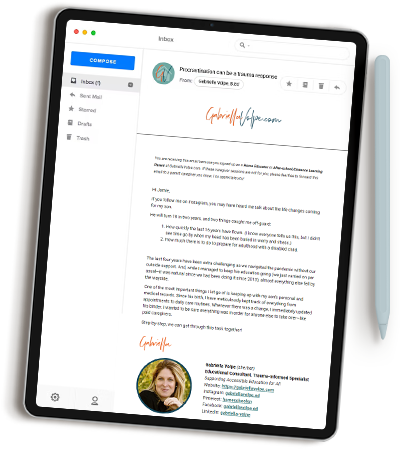AI in Education: Overcoming resistance and embracing change
Artificial Intelligence (AI) is reshaping education in ways we never imagined. Yet, despite its growing potential, many educators and therapists (and support staff) resist its integration.
Some fear AI will make our jobs redundant, while others are skeptical about its benefits. Others, yet, worry about plagiarism and cheating. However, resisting AI is not only unproductive; it could hinder the very learners who need personalized support the most.
This post will explore why there is resistance to AI and how embracing AI can lead to more inclusive, effective pedagogical and therapeutic practices that benefit professionals and their learners.
In this post:
- Common reasons educators and therapists resist AI
- Why AI should be viewed as a tool, not a threat
- Practical ways to embrace AI for neurodivergent and disabled learners

Child wearing headset using AI in the classroom
What is AI, and why is it important for educators and therapists?
AI, or artificial intelligence, refers to technology that can simulate human-like thinking, making decisions, and solving problems. In education, AI tools include adaptive learning platforms, real-time feedback systems, and assistive technologies that are already changing how we teach.
As AI grows more sophisticated, it can personalize learning in ways that are especially beneficial for neurodivergent and disabled learners.
Why It Matters
AI has the potential to remove barriers that neurodivergent and disabled students face in conventional educational settings. From text-to-speech to adaptive lesson plans, AI can help create learning environments that meet each learner’s unique needs and preferences.

Why are educators resisting AI?
Resistance to AI is rooted in a few common fears and misconceptions. Educators often fear that AI could make their roles redundant or that AI makes it too easy for learners to plagiarize and not expand their skills. These fears are understandable, but they stem from a misunderstanding of what AI can and cannot do.
We need to rethink the role of support professionals in this new era.

Why resisting AI hurts neurodivergent and disabled learners
AI isn’t going anywhere.
By resisting its integration into education, we risk leaving behind the learners who need support most. Neurodivergent and disabled learners often require individualized attention, and AI can be an invaluable tool in providing personalized learning paths, assistive technology, and real-time feedback.
Why AI is a tool, not a threat
- AI can’t replace human connection
AI might provide data-driven insights but cannot replicate the human warmth, empathy, and understanding educators bring to their work. Neurodivergent and disabled learners need this human connection to thrive, and AI can serve as a support mechanism to enhance, not replace that relationship. - AI supports individualized learning
Rather than being a one-size-fits-all solution, AI allows for adaptive learning tailored to each learner’s needs and preferences. - AI frees educators from administrative burdens
Educators often spend hours on administrative tasks. AI can automate many of these tasks, freeing up valuable time to focus on what matters most: the learners.
AI is just a tool that can’t replicate the human connection, understanding, and personalization that neurodivergent and disabled learners need.
How AI can empower educators and therapists
Rather than seeing AI as a threat, educators can view it as a powerful ally in providing the best possible support for neurodivergent and disabled learners. Here are some of the ways AI can empower educators and therapists:
Personalized learning paths
AI-driven platforms assess student progress in real time and adapt lessons based on individual learning preferences.
Assistive technologies
AI tools like text-to-speech and predictive text can significantly enhance accessibility for disabled learners.
Real-time feedback
AI provides immediate feedback, allowing students to learn from mistakes quickly and educators to adjust lessons on the fly.

Student using AI for homework
Practical ways educators can embrace AI
If you’re ready to embrace AI but don’t know where to start, here are questions I’ve been asking myself (and some answers to get us thinking about the solutions differently):
How do we change our approach to focus on actual learning (instead of worrying about plagiarism)?
- Shift from product-focused assignments (e.g., essays, reports, tests) to process-based assessments (e.g., drafts, reflections, journals)
- Focus on critical thinking, problem-solving, and creativity in assignments
- Incorporate peer review and self-assessment
- Design assessments that require applying knowledge in real-world scenarios (making it harder to rely on AI-generated answers!)
What kinds of assignments should we focus on?
- Open-ended questions
- Problem-solving tasks
- Research projects
- Collaborative projects
- Hands-on projects (e.g., experiments, fieldwork)
- Multimedia projects (e.g., videos, podcasts)
- Inquiry-based learning projects
- Projects tied to community or real-world challenges
How can we teach learners to use AI as a support tool rather than seeing it as an enemy?
- Use AI as a learning assistant, showing how it can help with research, brainstorming, or organizing ideas
- Teach learners how to evaluate AI-generated content (most of it sucks if not well prompted!)
- Encourage kids to use AI to enhance their work (e.g., spell-check, grammar check)
- Teach ethical and safe AI use
We’re not competing with AI but working with it.
Embrace AI as a tool for inclusion, not a threat
AI isn’t here to take over our jobs—it’s here to free us and change how we approach education, especially for those who need more individualized attention.
By embracing AI, educators, and therapists can offer the best of both worlds: cutting-edge tools combined with the irreplaceable human connection and expertise that neurodivergent and disabled learners rely on.
Related articles on this site
- Universal Design for Learning: UDL Strategies for Inclusive Learning Spaces
- What if educational change is possible?
- “This is how it’s always been taught …”
Related articles
- Forbes article: Artificial Intelligence In Education: Teachers’ Opinions On AI In The Classroom
- ChatGPT and Beyond: How to Handle AI in Schools
Sources
Nahas E., Diab P., & Atechian T. (2024) Brainy: An Innovative Context-Aware Generative AI Engine for Education ISSN: 2435-5240 The Southeast Asian Conference on Education 2024: Official Conference Proceedings (pp. 465-474) https://doi.org/10.22492/issn.2435-5240.2024.42
Ruan, S., Nie, A., Steenbergen, W. et al. Reinforcement learning tutor better supported lower performers in a math task. Mach Learn 113, 3023–3048 (2024). https://doi.org/10.1007/s10994-023-06423-9
Wang, X., Huang, R. “Tammy”, Sommer, M., Pei, B., Shidfar, P., Rehman, M. S., Ritzhaupt, A. D., & Martin, F. (2024). The Efficacy of Artificial Intelligence-Enabled Adaptive Learning Systems From 2010 to 2022 on Learner Outcomes: A Meta-Analysis. Journal of Educational Computing Research, 62(6), 1568-1603. https://doi.org/10.1177/07356331241240459
Get more anecdotes and strategies like this one

Sign-up to my newsletter for professionals
By signing up for email alerts, you agree to receive updates and promotions to support you in your role in education or therapy. You can unsubscribe at any time.

0 Comments